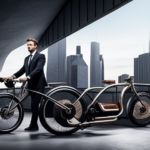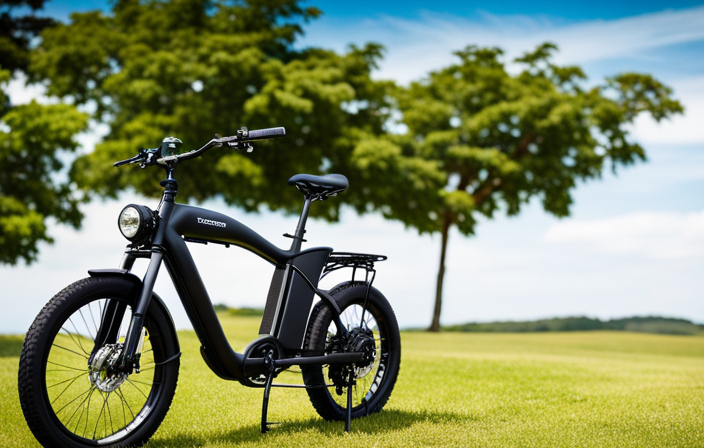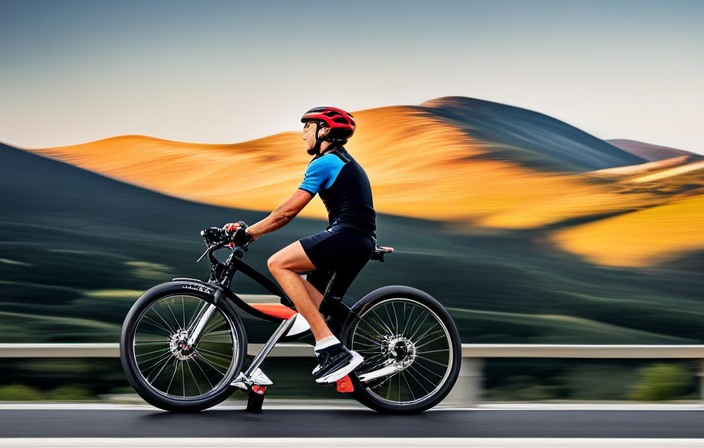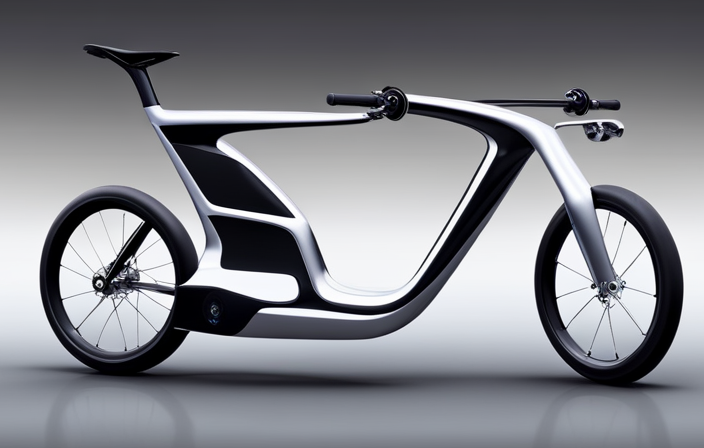Ready to turn your ordinary bike into an electrifying ride? Get ready to pedal into the future with this step-by-step guide on how to make your bike an electric bike. It’s like giving your trusty two-wheeler a turbo boost!
In this article, I’ll walk you through the basics of electric bike conversion, help you choose the right conversion kit, and provide tips on upgrading your new electric ride.
So strap on your helmet and let’s get started on this electrifying adventure!
Key Takeaways
- Familiarize yourself with pedal assist levels and throttle control.
- Regularly check tire pressure and chain tension.
- Keep the battery charged and clean the contacts regularly.
- Perform regular maintenance checks on brakes, tires, lights, and battery.
Understand the Basics of Electric Bike Conversion
You’ll need to understand the basics of electric bike conversion before you can start converting your bike.
The electric bike conversion process involves transforming a regular bike into an electric bike by adding a motor, battery, and controller.
The advantages of electric bike conversion are numerous. Firstly, it allows you to enjoy the benefits of an electric bike without having to buy a completely new one. Secondly, it is a cost-effective option compared to purchasing an electric bike. Additionally, converting your bike allows you to customize it according to your preferences.
To begin the conversion process, you’ll need to gather the necessary tools and materials. This includes a motor kit, battery pack, controller, wiring, and various hardware.
Gather the Necessary Tools and Materials
Start by gathering all the tools and materials needed for the conversion. Understanding electric bike components is crucial before diving into the conversion process. Here is a list of necessary tools and materials to get you started:
| Tools | Materials |
|---|---|
| Wrench set | Electric bike motor |
| Screwdriver set | Battery pack |
| Allen key set | Controller |
| Wire cutter | Throttle |
| Wire stripper | Wiring harness |
These tools and materials will help you troubleshoot common conversion issues and ensure a successful conversion. Once you have everything gathered, you can move on to the next step of choosing the right electric bike conversion kit for your bike. This will allow you to seamlessly transition into the subsequent section and continue your journey towards an electric bike transformation.
Choose the Right Electric Bike Conversion Kit for Your Bike
First, consider which electric bike conversion kit is the best fit for your bicycle. Choosing the right conversion kit is crucial to ensure a successful transformation of your bike into an electric one. Factors to consider when selecting a conversion kit include the type of bike you have, your budget, and your desired level of power and performance.
- Compatibility: Make sure the conversion kit is compatible with the size and type of your bike, including the wheel size and frame design.
- Power and Range: Consider the motor power and battery capacity to match your cycling needs and the terrain you will be riding on.
- Installation Process: Look for conversion kits that come with detailed instructions and are easy to install.
By carefully weighing these factors, you can select the perfect electric bike conversion kit for your needs. Once you have chosen the right kit, you can move on to preparing your bike for the conversion process.
Prepare Your Bike for the Conversion Process
Before beginning the conversion process, it’s important to ensure that your bicycle is properly prepared.
The first step in preparing your bike for the modification is to thoroughly clean it. Remove any dirt, grease, or debris from the frame, wheels, and components. This will ensure a smooth and secure installation of the electric bike conversion kit.
Next, inspect your bike for any damages or worn-out parts that may need to be replaced. Check the tires, brakes, chain, and gears for any signs of wear and tear. It’s important to have a bike in good condition to fully enjoy the benefits of an electric bike.
Once your bike is clean and in good working order, you can proceed to the next step of installing the electric bike conversion kit, which will be covered in the following section.
Install the Electric Bike Conversion Kit
To begin installing the electric bike conversion kit, ensure that your bicycle is clean and in good working condition. A clean bike will make the installation process smoother and prevent any dirt or debris from interfering with the components of the conversion kit.
Once your bike is ready, follow these steps to install the electric bike conversion kit:
-
Attach the motor: Position the motor on the bike frame using the provided brackets and secure it tightly with bolts. Make sure the motor is aligned with the chain and pedal system.
-
Connect the battery: Locate the battery mount on your bike and attach the battery securely. Connect the wiring harness from the motor to the battery, ensuring the connections are tight.
-
Install the controller: Mount the controller near the handlebars and connect it to the battery and motor. This will allow you to control the speed and power of your electric bike.
Converting your bike to an electric one using the electric bike conversion guide offers numerous benefits, including increased speed and distance coverage. Once the kit is installed successfully, you can proceed to the next step of connecting and securing the battery and motor.
Connect and Secure the Battery and Motor
Attach the motor to your bike frame, ensuring it is aligned with the chain and pedal system, and secure it tightly with bolts. To ensure proper battery placement, refer to the manufacturer’s instructions for your specific electric bike conversion kit. The battery is typically mounted on the frame or in a saddlebag, securely fastened with straps or brackets. It’s important to consider the weight distribution and ensure the battery doesn’t interfere with your pedaling. Additionally, check the motor compatibility with your bike’s frame and wheel size. Different conversion kits may have specific requirements. Refer to the kit’s manual for guidance on compatibility and adjustments needed. Once the battery and motor are connected and secured, you are ready to test the electric bike conversion and experience the thrill of riding with electric assistance.
Test the Electric Bike Conversion
Once the battery and motor are securely connected and mounted, it’s time to test out your newly converted electric bike.
Testing the electric bike conversion is an important step to ensure everything is functioning correctly before hitting the road.
Begin by turning on the power switch and checking if the motor starts running smoothly. Listen for any unusual noises or vibrations that may indicate a problem.
Next, take a short test ride to gauge the speed and acceleration of the bike. Pay attention to the responsiveness of the motor and brakes.
If any issues arise during the testing process, troubleshooting tips can be found in the conversion kit’s manual or by contacting the manufacturer.
Once you are satisfied with the performance, you can move on to the next section and begin adjusting and fine-tuning your electric bike for optimal performance.
Adjust and Fine-Tune Your Electric Bike
Now it’s time to fine-tune and make adjustments to optimize the performance of your newly converted e-bike.
To ensure smooth and efficient operation, there are a few adjustment techniques you can follow. First, check the brakes to ensure they are properly aligned and responsive. Adjust the brake pads if necessary, ensuring they make even contact with the wheel rims.
Next, focus on the gears and drivetrain. Make sure the chain is properly tensioned and lubricated, and adjust the derailleurs for smooth shifting.
Additionally, check the tire pressure and make any necessary adjustments.
Troubleshooting tips include checking all electrical connections, ensuring the battery is securely fastened, and checking for any loose or worn-out components.
Once these adjustments are made, you’ll be ready to learn how to operate and maintain your electric bike smoothly.
Learn How to Operate and Maintain Your Electric Bike
To effectively operate and maintain your e-bike, it is important to familiarize yourself with its various features and functions. Here are some operating tips and a maintenance schedule to keep your electric bike running smoothly:
- Always wear a helmet and follow traffic rules for safety.
- Familiarize yourself with the pedal assist levels and throttle control.
- Regularly check tire pressure and ensure proper chain tension.
- Keep the battery charged and clean the contacts regularly.
- Lubricate the chain and gears to reduce wear and tear.
By following these operating tips and adhering to a maintenance schedule, you can ensure the longevity and optimal performance of your electric bike.
Now, let’s move on to the next section and discover how you can enjoy the benefits of your newly converted electric bike.
Enjoy the Benefits of Your Newly Converted Electric Bike
Get ready to experience the advantages of your newly converted e-bike. Now that your bike is electric, you can maximize its performance and enjoy a whole new level of biking.
To get the most out of your electric bike, it’s important to understand how to extend its battery life. Start by charging your battery fully before each ride and avoid letting it completely drain. Additionally, keep your battery at a moderate temperature and avoid exposing it to extreme heat or cold.
Another way to maximize performance is to adjust your riding style. Use a combination of pedal-assist and throttle modes to conserve battery power.
And remember, be mindful of safety precautions when riding your electric bike, ensuring a smooth transition into the next section.
Follow Safety Precautions When Riding Your Electric Bike
Remember, it’s important to follow safety precautions when riding your e-bike. To ensure your safety and the safety of others, here are three key steps to keep in mind:
-
Wear appropriate safety gear: Protect yourself by wearing a properly fitted helmet, gloves, and knee and elbow pads. This will minimize the risk of injury in case of an accident.
-
Observe traffic rules: Just like any other vehicle on the road, you should adhere to traffic laws, including signaling your turns, stopping at red lights, and yielding to pedestrians. This will help you avoid accidents and ensure a smooth flow of traffic.
-
Perform regular maintenance checks: Keep your electric bike in optimal condition by regularly inspecting the brakes, tires, lights, and battery. This will help prevent malfunctions and ensure a safe and enjoyable ride.
By following these electric bike safety guidelines and wearing the proper gear, you can confidently enjoy your e-bike rides. Consider upgrading your electric bike with additional accessories to enhance your experience even further.
Consider Upgrading Your Electric Bike with Additional Accessories
After ensuring the safety of your electric bike, it’s time to take it to the next level by considering some exciting upgrade options. Upgrading your electric bike can enhance its performance, functionality, and overall riding experience. There are various accessories available in the market that can be easily installed on your bike. To simplify your decision-making process, I have compiled a table below detailing some popular upgrade options along with cost considerations:
| Upgrade Option | Description | Cost Range |
|---|---|---|
| Upgraded battery | Increases the range of your electric bike | $200 – $500 |
| Front suspension | Provides a smoother ride over rough terrains | $100 – $300 |
| Rear rack | Adds storage capacity for carrying belongings | $50 – $150 |
| LED lights | Enhances visibility and safety during night rides | $20 – $50 |
| Smartphone mount | Allows you to navigate and track your rides | $10 – $30 |
By upgrading your electric bike with these accessories, you can customize it to meet your specific needs and preferences. Once you have made these improvements, it’s time to join electric bike communities and online forums for support and advice, as they can provide valuable insights on further upgrades and maintenance tips.
Join Electric Bike Communities and Online Forums for Support and Advice
To fully immerse yourself in the electric bike community and gain valuable support and advice, consider joining online forums and communities where you can connect with fellow enthusiasts. These communities provide a platform to ask questions, share experiences, and learn from others who have already converted their bikes to electric.
By joining these online forums, you can find valuable information on the best electric bike conversion kits, troubleshooting common issues, and even discover new accessories to enhance your electric bike experience. Additionally, these communities often organize local group rides and discussions, allowing you to meet and connect with other electric bike enthusiasts in your area.
Engaging in these group activities not only expands your knowledge but also helps you build a network of like-minded individuals. Transitioning into the next section, exploring local laws and regulations regarding electric bikes is essential to ensure a safe and legal riding experience.
Explore Local Laws and Regulations Regarding Electric Bikes
You should familiarize yourself with the local laws and regulations regarding the use of electric bikes in your area.
Start by exploring local regulations to understand the specific requirements and restrictions for electric bikes. Some areas may have speed limits, age restrictions, or specific helmet laws that you need to be aware of.
Additionally, it’s important to find suitable conversion kits that comply with these regulations. Look for kits that meet the power and speed limits set by your local laws. This will ensure that your electric bike is legal and safe to ride.
Once you have a clear understanding of the regulations and have found a suitable conversion kit, you can proceed with the conversion process.
Share your electric bike conversion experience with others to inspire and educate them about the benefits of electric bikes.
Share Your Electric Bike Conversion Experience with Others
Share with others your experience of converting a regular bicycle into an electric bike.
Converting a bike into an electric one can be a rewarding and cost-effective project. However, it is important to avoid common electric bike conversion mistakes and be prepared to troubleshoot any issues that may arise.
Here are three key points to consider:
-
Choose the right conversion kit: Ensure that the kit you select is compatible with your bike’s frame and wheel size. Consider factors such as motor power, battery capacity, and controller features.
-
Proper installation: Follow the manufacturer’s instructions carefully during the installation process. Pay attention to wiring connections, motor alignment, and securing all components properly.
-
Troubleshooting common issues: Be prepared to address common electric bike conversion issues such as battery not charging, motor not working, or intermittent power. Check for loose connections, faulty wiring, or insufficient battery voltage.
By sharing your experience and knowledge, you can help others avoid mistakes and troubleshoot common issues when converting a regular bicycle into an electric bike.
Frequently Asked Questions
Can I convert any type of bike into an electric bike?
Yes, any type of bike can be converted into an electric bike. The bike weight may increase due to the addition of an electric motor and battery. The battery capacity will determine the range and performance of the electric bike.
How long does it typically take to install an electric bike conversion kit?
Typically, it takes around 1-2 hours to install an electric bike conversion kit. To ensure a smooth installation, follow these troubleshooting tips: check all connections, secure the battery properly, and test the system before riding.
Are there any specific tools or skills required for the conversion process?
To convert a bike to electric, you’ll need basic tools like wrenches and screwdrivers, along with specific tools like a torque wrench and cable cutters. Basic mechanical skills, like bike maintenance and electrical wiring, are also necessary.
What is the average cost of an electric bike conversion kit?
The average price of an electric bike conversion kit can range from $300 to $1000. However, investing in a high-quality kit from the best brands like BAFANG or Tongsheng ensures reliability and a better overall experience.
Are there any limitations or restrictions on using an electric bike on public roads or bike paths?
To ride an electric bike on public roads and bike paths safely, it is important to consider safety concerns and follow legal regulations. Wear a helmet, obey traffic laws, and understand the speed limits and restrictions in your area.
Conclusion
In conclusion, converting my bike into an electric bike was a thrilling and rewarding experience. I learned the basics, gathered the necessary tools, and chose the perfect conversion kit for my needs.
With careful preparation and installation, my bike was transformed into a powerful and efficient electric ride. I even had the opportunity to upgrade it with cool accessories.
Being part of electric bike communities and forums provided valuable support and advice. Lastly, it’s important to familiarize yourself with local laws and regulations.
Sharing my electric bike conversion journey has inspired others to take the leap and join the electrifying revolution.
















